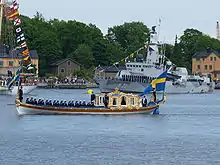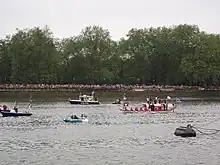Royal barge
A royal barge is a ceremonial barge that is used by a monarch for processions and transport on a body of water.

Royal barges are currently used in monarchies such as the United Kingdom, Sweden and Thailand.
Traditionally the use of royal barges was of high importance in Southeast Asian monarchies such as Siam, Burma, Brunei, Riau and Cambodia.
Belgium
In the 19th century, when a head of state visited a port city, it was traditional to invite them aboard a royal barge. This was why the Belgian government decided, on the recommendation of the King Leopold I, to have the Lecarpentier shipyards in Antwerp build a royal barge. Launched on 12 July 1835, Canot Royal carried the royal couple for the first time from Brussels to Antwerp via the Rupel to watch a military flotilla. Subsequently, Leopold I used the Canot Royal during his various trips to Antwerp, Ghent and Ostend. On 10 July 1862, in Antwerp, the Canot Royal brought Prince Louis of Hesse and his wife Princess Alice to the quay on the occasion of their honeymoon aboard the British Royal Yacht Victoria and Albert.
On 5 November 1899, RV Belgica returned to Antwerp. Canot Royal picked up Adrien de Gerlache and his mate, Georges Lecointe, to bring them aboard the mail ship Princess Clémentine, where government officials and their close families waited to greet them. On 7 December 1901, the Canot Royal was retired and disassembled. Parts of the Canot Royal are kept at the Royal Military Museum and at Royal Palace of Brussels.[1][2]
In 2022 L'Atelier Marin/Maritiem Atelier announced plans to make a replica of the royal barge.[3]
Burma (Myanmar)

The royal barge, called phaungdaw (ဖောင်တော်), was of historic importance during the monarchical era, and retains cultural significance in modern-day Myanmar (Burma).
The Karaweik barge on Yangon's Kandawgyi Lake and an iconic symbol of the city, was designed by Burmese architect Ngwe Hlaing, and was based on a royal barge.[4]

Hpaung Daw U Pagoda, which is situated on Inle Lake, is known for a major pagoda festival during which four of the Buddha images from the pagoda are placed on a royal barge designed as a hintha bird and taken throughout Inle Lake.

The royal barge was an important ceremonial possession of the Burmese monarchy, and was used for ceremonial and state affairs, such as a procession around the royal palace moat following a monarch's coronation. By the Konbaung dynasty, several types of royal state barges existed, each distinguished by a specific mythical figurehead at the front of the barge, and each allocated to different members of the royal court:
- Pyigyimon (ပြည်ကြီးမွန်) - two conjoined gilded barges crowned with a seven-tiered roof (pyatthat), with dragon-headed hulls and carved figureheads of the garuda (a mythical bird) and naga (a mythical serpent), and Thagyamin at the center[5]
- Nawarupa (နဝရူပ) - used by the royal ministers and officers, with a figurehead of a nawarupa (a chimeric animal with the mane of a karaweik, the hump of bull, the tail of a ngagyin fish, two elephant tusks, the trunk of a makara, and horns of a toe naya, two wings of parakeet, and a front and hind leg of a horse)[5]
- Nagadewa (နာဂဒေဝ) - used by the royal ministers and officers, with the figurehead of a nagaraja[5]
- Pyinsarupa (ပဉ္စရူပ) - used by the chief queens, a gilt barge with the figurehead of a pyinsarupa (a chimeric animal with the mane of karaweik bird, the tusk and trunk of an elephant, the hump of bull, the tail of a ngagyin fish, and the horns of a toe naya)[5]
- Eni (ဧဏီ) - a barge adorned with the figurehead of a deer[5]
- Hintha (ဟင်္သာ) - used by princes, a barge adorned with the figurehead of a hamsa (mythical bird)[5]
- Udaung (ဥဒေါင်း) - used by princes, a barge adorned with the figure of peacock[5]
The elaborate figureheads and motifs used in Burmese royal barges influenced the construction of increasingly elaborate Siamese royal barges toward the end of the Ayutthaya period.[6]
Sweden

Vasaorden is the Swedish royal barge. The original royal barge of this name was built in 1774 on the orders of King Gustav III, to a design by Fredrik Henrik af Chapman, but was destroyed in a dockyard fire in 1921. A private fundraising led to a new barge being constructed in 1923 with the help of the old blueprints. The Vasaorden is used on special occasions such as royal weddings.[7]
Thailand
The Royal Barge Procession is a ceremony of both religious and royal significance which has been taking place for nearly 700 years. Some of the royal barges are kept at the National Museum of Royal Barges.
United Kingdom
The Thames was a regular thoroughfare for the Sovereign until the middle of the 19th century, on state occasions or between the Royal Palaces of Windsor, Westminster, Hampton Court, Greenwich and the Tower of London. The travel of the monarch by barge is managed by the King's Bargemaster and Royal Watermen, chosen from the Company of Watermen and Lightermen. Though there is currently no official state barge, a number of boats in recent years have stepped into the role of Royal Barge for various specific ceremonies and occasions:[8]
Royal Nore
Until 2017[9] the Royal Nore, owned and maintained by the Port of London Authority, was used whenever a member of the Royal Family travelled on the river Thames for an official engagement.[10]
The Royal Standard and Regalia were displayed when Queen Elizabeth was on board. The Queen was always accompanied by her Bargemaster, along with eight Royal Watermen in full ceremonial dress standing on the fore deck.[11]
Royal Nore was at the centre of the River Progress and Pageant held to celebrate the Queen's Silver Jubilee in June 1977. At the time the vessel was named ‘Nore’; she was subsequently renamed Royal Nore in recognition of her service, by Royal Command.[9] She is permanently berthed at Ocean Terminal, Leith, in Edinburgh, Scotland, alongside the similarly retired Royal Yacht, HMY Britannia.
Royal Shallop Jubilant

The Royal Shallop Jubilant was built for the Golden Jubilee of Elizabeth II. The vessel itself was modelled on the Naval Victualling Commissioners’ Barge held at the National Maritime Museum. It was designed with accessibility in mind, to help those with disabilities and disadvantages take part in rowing.[12][13]
Gloriana

A new royal barge named Gloriana was built in 2011–2012 to mark the Queen's Diamond Jubilee. Gloriana is a rowing barge, powered by 18 oarsmen; it took a leading position in the Thames Diamond Jubilee Pageant on 3 June 2012 and carried ten flags, among them those representing the four home nations: England, Scotland, Wales and Northern Ireland,[14] as well as the flag of the City of London and the flag of Cornwall.
HMY Britannia, Royal Barge

The Royal Barge was a tender for HMY Britannia traditionally used to transport the Royal Family to and from The Royal Yacht. As part of the Queen's Diamond Jubilee, the vessel was re-commissioned to take part in the Thames Pageant. The vessel carried the Queen to and from the larger Spirit of Chartwell, along with two Royal Watermen in full ceremonial dress. After the Pageant the vessel was returned to Leith to sit on display alongside the Royal Yacht Britannia.[15][16]
MV Spirit of Chartwell

During the celebrations on 3 June 2012, the Queen travelled aboard the MV Spirit of Chartwell, which acted as Royal Barge for the occasion.[17] A special warrant was issued by the Secretary of State for Defence to permit the MV Spirit of Chartwell to wear the White Ensign whilst serving as the Royal Barge on 3 June 2012.[18] When the Queen was on board, it also flew the Royal Standard of the United Kingdom from the bow.
See also
- Pleasure barge
- Bucentaur, the ceremonial barge of the Venetian doge
- State Barge of Charles II
- Queen Mary's Shallop
- Prince Frederick's Barge
References
- "Canot Royal". www.marinebelge.be. Retrieved 2022-09-02.
- "Le Canot Royal". www.marine-mra-klm.be. Retrieved 2022-09-02.
- "L'atelier marin lance un nouveau projet". L'Atelier Marin ASBL. Retrieved 2022-09-02.
- Tin Mg Oo (2003). Aspects of Myanmar Culture. Yangon: Zun Pwint Publishing House. pp. 78–79.
- "Beautiful Burmese Barges and Boats - Asian and African studies blog". British Library. Retrieved 2020-12-12.
- Wales, H. G. Quaritch (2019-05-23). Siamese State Ceremonies: Their History and Function With Supplementary Notes. Routledge. ISBN 978-1-136-77636-6.
- "Sailors Train for Royal Wedding Mission". Sveriges Radio. 31 March 2010.
- "The Queen's Watermen". The Royal Family. 15 January 2016.
- "Royal Nore to Leave Thames for Royal Yacht Britannia Trust Collection".
- "The Queen's Watermen". The Royal Household. 15 January 2016. Retrieved 2016-07-03.
- "The Royal Nore". The Fleet. Woods' Silver Fleet. Archived from the original on June 2, 2011. Retrieved 2011-06-02.
- "History - the Jubilant Trust".
- "14th Richmond Viking Scout Boat Centre – Our Boats".
- Bartram, A Visual Guide... p.5.
- "Royal barge joins Queen's Diamond Jubilee celebrations". BBC News. 9 March 2012.
- "Forces Vessels and Lifeboats - the Queen's Pageant". 10 May 2012.
- Paul Harrison (11 December 2011). "Royal Barge 'Jewel' For The Queen's Jubilee". Sky News. Retrieved 9 April 2012.
- Bartram, A Visual Guide... p.16.
Sources
- Bartram, Graham (2012). "A Visual Guide to the Flags used in the Thames Diamond Jubilee Pageant" (PDF). The Flag Institute. Archived from the original (PDF) on 7 March 2014. Retrieved 7 June 2012.